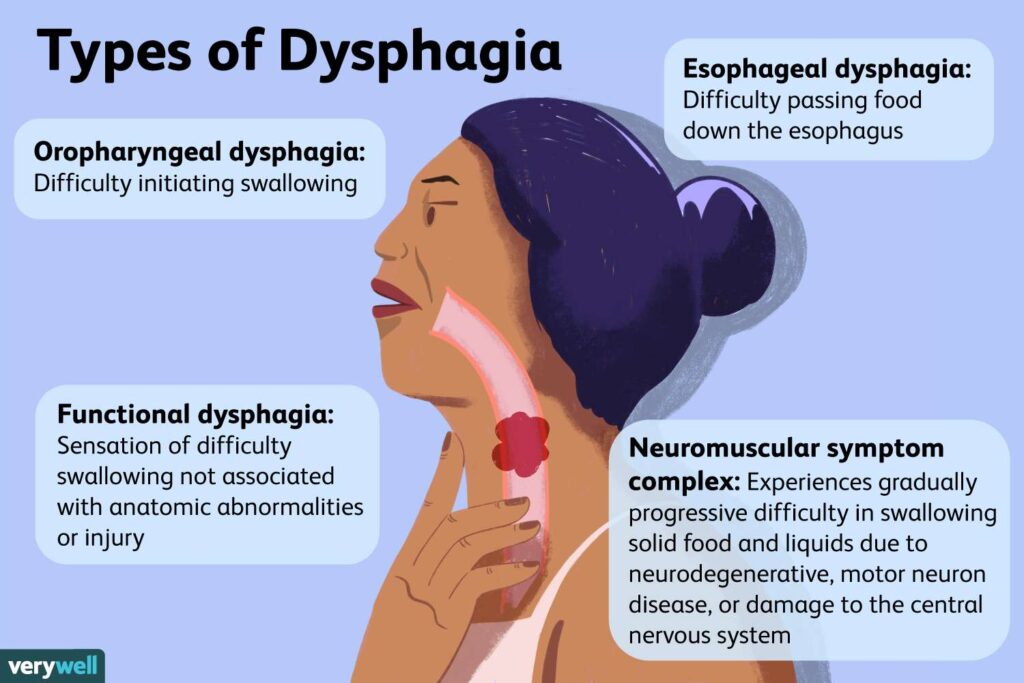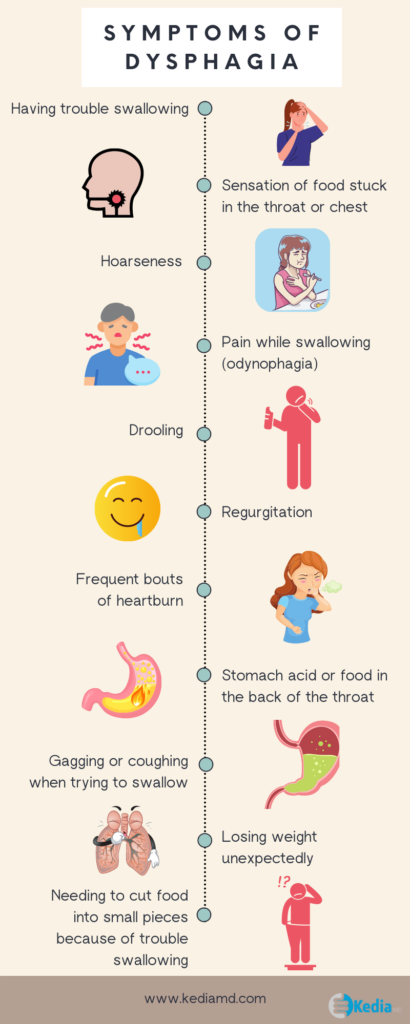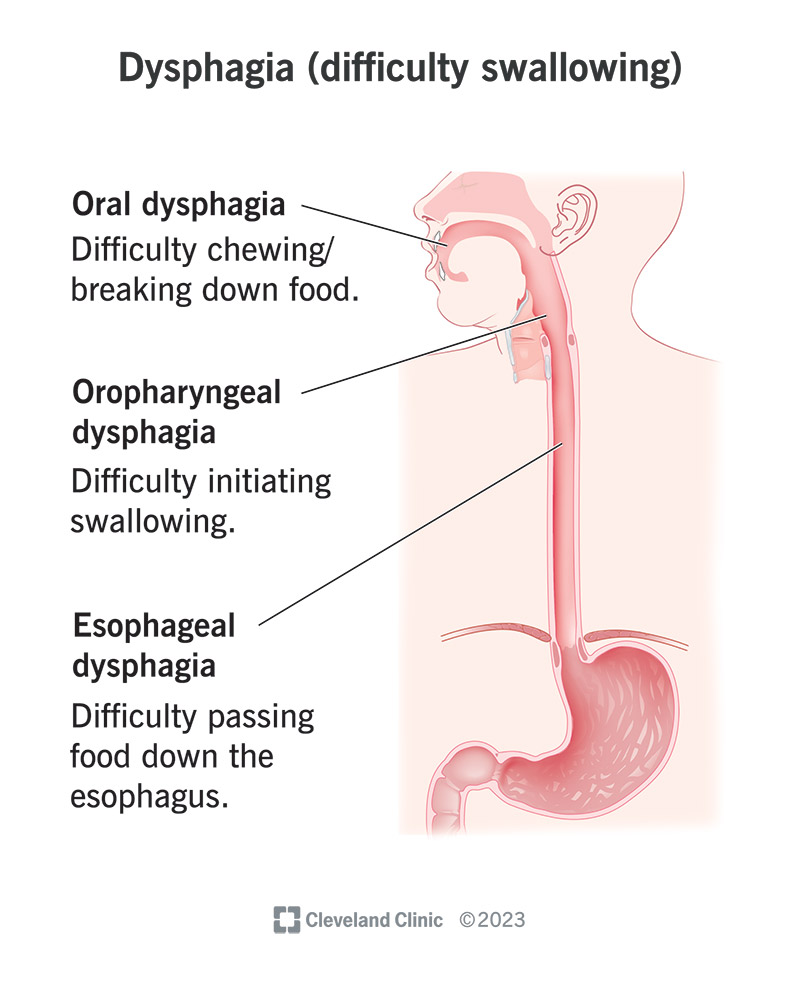Are you familiar with the term dysphagia? If not, don’t worry, because in this article, we will explore the causes, symptoms, and treatment options for this often undiagnosed condition. Dysphagia, which refers to difficulty swallowing, can affect people of all ages, from infants to the elderly. Despite its prevalence, many individuals are unaware of dysphagia and its potential impact on their daily lives. By understanding the underlying causes, recognizing the symptoms, and exploring effective treatment methods, you can empower yourself and your loved ones to navigate this condition with confidence and ease. Let’s delve into the world of dysphagia together and unlock the knowledge that can make a real difference.

Causes of Dysphagia
Dysphagia, or difficulty swallowing, can have various causes that can be grouped into different categories. Understanding the underlying causes of dysphagia is crucial in diagnosing and treating the condition effectively.
Neurological Causes
Neurological causes of dysphagia occur when there is a dysfunction or damage to the nerves and muscles involved in swallowing. Conditions such as stroke, Parkinson’s disease, multiple sclerosis, and amyotrophic lateral sclerosis (ALS) can all affect the ability to swallow properly. These conditions can disrupt the coordination of the muscles responsible for swallowing and result in dysphagia.
Muscular Causes
Muscular causes of dysphagia typically arise from weakened or impaired muscles in the throat and esophagus. Disorders like muscular dystrophy, myasthenia gravis, and certain metabolic disorders can lead to muscle weakness and interfere with the normal swallowing process. Additionally, conditions that cause muscle spasms, such as achalasia or cricopharyngeal spasm, can also contribute to dysphagia.
Structural Causes
Structural causes of dysphagia involve physical blockages or obstructions in the swallowing pathway. These obstacles can include strictures or narrowing of the esophagus, tumors in the throat or esophagus, or the presence of a foreign object in the throat. Conditions like gastroesophageal reflux disease (GERD), esophageal diverticulum, or esophageal webs can also contribute to dysphagia by creating structural abnormalities that impede the smooth passage of food or liquid.
Psychological Causes
Psychological causes of dysphagia are less common and often related to psychological disorders or eating disorders. Conditions such as anxiety, depression, obsessive-compulsive disorder (OCD), or phobias can lead to difficulty swallowing due to heightened emotional distress or fear associated with eating. This type of dysphagia may manifest as a sensation of food getting stuck in the throat or as a reluctance to swallow.
Types of Dysphagia
Dysphagia can be categorized into different types based on the underlying cause and the location of the swallowing difficulties. Understanding the specific type of dysphagia is essential in determining the appropriate treatment approach.
Oropharyngeal Dysphagia
Oropharyngeal dysphagia refers to difficulties in the oral and pharyngeal phases of swallowing. This type of dysphagia typically results from problems with muscle coordination or strength in the mouth and throat. Symptoms may include choking or coughing while eating, difficulty initiating a swallow, or the sensation of food or liquid getting stuck in the throat.
Esophageal Dysphagia
Esophageal dysphagia occurs when there are disruptions or abnormalities in the esophagus that hinder the smooth passage of food or liquids. This type of dysphagia often manifests as a sensation of food sticking or getting lodged in the chest, discomfort or pain during swallowing, or a feeling of food or liquids coming back up (regurgitation) after swallowing.
Functional Dysphagia
Functional dysphagia is a type of swallowing difficulty where no physical cause can be identified. This type of dysphagia is often associated with psychological factors or disorders like anxiety or depression. Individuals with functional dysphagia may experience difficulty swallowing across multiple food consistencies and have symptoms that are not specific to any particular phase of swallowing.
Ideational Dysphagia
Ideational dysphagia is a relatively rare type of swallowing disorder that occurs when there is a breakdown in the cognitive aspects of swallowing. This means that a person may have difficulty understanding or recognizing food and beverages as objects to consume, leading to a reluctance or avoidance of eating altogether. Ideational dysphagia is often associated with neurological conditions or cognitive impairments.

Symptoms of Dysphagia
Recognizing the symptoms of dysphagia is crucial in seeking appropriate medical attention and getting an accurate diagnosis. While the specific symptoms may vary depending on the underlying cause and type of dysphagia, there are some common signs to watch out for.
Difficulty or pain while swallowing
One of the most common symptoms of dysphagia is the sensation of difficulty or pain when trying to swallow food, liquids, or even saliva. This discomfort can range from mild to severe and may feel like food is getting stuck in the throat or chest.
Coughing or choking while eating or drinking
Coughing or choking episodes while eating or drinking can indicate a problem with swallowing. This happens when food or liquids enter the airway instead of going down into the esophagus, leading to a reflexive cough or choking response.
Recurrent respiratory infections
Dysphagia can increase the risk of recurrent respiratory infections, such as pneumonia or bronchitis. When food or liquids enter the airway, they can cause aspiration pneumonia, an infection in the lungs that occurs when foreign substances are inhaled.
Weight loss or malnutrition
A consistent difficulty with swallowing can make it challenging to consume an adequate amount of food and liquids. This can lead to unintentional weight loss and malnutrition, as the body is not receiving the necessary nutrients for optimal health.
It is important to note that the severity and combination of symptoms may vary from person to person. If you experience any persistent or concerning symptoms related to swallowing, it is recommended to consult a healthcare professional for evaluation and appropriate management.
Diagnosing Dysphagia
Diagnosing dysphagia involves a comprehensive assessment of a person’s medical history, physical examination, and specialized tests to determine the cause and severity of the swallowing difficulty. An accurate diagnosis is crucial in developing an appropriate treatment plan.
Medical History and Physical Examination
The initial step in diagnosing dysphagia is obtaining a detailed medical history, including information about current symptoms, duration of the problem, any related medical conditions, and any medications that might contribute to swallowing difficulties. A physical examination may also be conducted to assess any visible abnormalities in the oral cavity, throat, or neck.
Videofluoroscopy
Videofluoroscopy, also known as a modified barium swallow study, is a specialized radiographic examination that allows healthcare professionals to observe the swallowing process in real-time. During this test, the individual consumes various food and liquid consistencies that have been mixed with a contrast agent visible on X-rays. This enables the healthcare team to visualize any abnormalities or difficulties that may be occurring during swallowing.
Fiberoptic Endoscopic Evaluation of Swallowing
Fiberoptic endoscopic evaluation of swallowing (FEES) is a procedure where a flexible endoscope is passed through the nasal cavity to the back of the throat. This allows for a direct visualization of the structures involved in swallowing, including the larynx, pharynx, and upper esophagus. During the examination, the individual may be asked to swallow food or liquid with various consistencies to assess the function and coordination of the swallowing process.

Treatment of Dysphagia
The treatment of dysphagia depends on the underlying cause and severity of the swallowing difficulty. A multidisciplinary approach involving healthcare professionals from various specialties, such as speech-language pathology, gastroenterology, and neurology, is often necessary to provide comprehensive care.
Speech Therapy and Swallowing Exercises
Speech therapy is a cornerstone in the treatment of dysphagia. A speech-language pathologist (SLP) can evaluate the swallowing difficulties, provide recommendations for safe swallowing techniques, and design a personalized exercise program to improve swallowing function. These exercises may include various maneuvers and techniques to strengthen and coordinate the muscles involved in swallowing.
Medications
In some cases of dysphagia, medications may be prescribed to manage underlying conditions or symptoms that contribute to swallowing difficulties. For example, medications to reduce acid reflux in GERD or muscle relaxants to reduce esophageal spasms may be prescribed, depending on the specific diagnosis.
Dietary Modifications
Dietary modifications play a significant role in managing dysphagia. Depending on the type and severity of dysphagia, a speech-language pathologist or dietitian may recommend modifying the texture or consistency of food and liquids to make them easier to swallow safely. This may involve blending or pureeing food, thickening liquids, or avoiding certain types of food that are difficult to swallow.
Surgery
In cases of dysphagia caused by structural abnormalities or obstructions, surgical intervention may be necessary. Procedures such as esophageal dilation, removal of tumors or strictures, or the placement of feeding tubes may be considered to improve swallowing function and maintain adequate nutrition.
It is important to note that the treatment approach for dysphagia may vary depending on the individual’s specific needs and the recommendations of the healthcare team. Regular follow-up evaluations may be necessary to monitor progress and adjust the treatment plan as needed.
Complications of Dysphagia
If left untreated or poorly managed, dysphagia can lead to various complications that can significantly impact an individual’s health and well-being. It is crucial to address and manage dysphagia effectively to prevent these potential complications.
Aspiration Pneumonia
One of the most serious complications of dysphagia is aspiration pneumonia, as mentioned earlier. When food or liquids enter the airway instead of the esophagus, they can reach the lungs, leading to respiratory infections. Aspiration pneumonia can be life-threatening, especially in individuals with compromised immune systems or underlying respiratory conditions.
Dehydration and Malnutrition
When swallowing difficulties make it challenging to consume enough fluids and appropriate nutrition, dehydration and malnutrition can occur. Without sufficient hydration and essential nutrients, the body may become weakened and more susceptible to infections, wound healing delays, and other adverse health consequences.
Psychosocial Impact
Dysphagia can have a significant impact on a person’s quality of life and overall well-being. The frustration and challenges associated with eating and drinking can lead to social isolation, anxiety, depression, and reduced enjoyment of mealtimes. It is important for individuals with dysphagia to receive emotional support and counseling to cope with the psychosocial impact of the condition.
Weight Loss
Persistent difficulty with swallowing and inadequate intake of food and liquids can result in unintentional weight loss. This can have further negative effects on overall health and may exacerbate other underlying conditions.
It is important for individuals with dysphagia to seek appropriate medical attention and follow recommended treatment plans to minimize the risk of complications. Regular monitoring and adjustments to treatment strategies can help address complications and improve quality of life.
Tips for Eating with Dysphagia
While the treatment of dysphagia is crucial, there are also practical strategies and tips that individuals with dysphagia can incorporate into their daily lives to improve their swallowing safety and overall meal experience.
Eat slowly and take small bites
Eating slowly and taking smaller bites can help reduce the risk of choking and aspiration. By allowing ample time to chew food thoroughly and swallow between bites, individuals with dysphagia can better control the movement of food through their throat and reduce the likelihood of food getting stuck.
Avoid foods that are difficult to swallow
Certain foods may pose a higher risk for individuals with dysphagia. Hard, crunchy, or sticky foods, as well as foods with large chunks or seeds, can be more challenging to swallow safely. It is advisable to avoid these types of foods or modify their consistency to make them easier to manage.
Modify food consistency
Modifying the consistency of food and liquids can significantly improve swallowing safety for individuals with dysphagia. Depending on the specific recommendations from healthcare professionals, blending, pureeing, or softening food can make it easier to swallow. Liquids can be thickened to reduce the risk of aspiration.
Stay upright while eating
Maintaining an upright sitting position while eating and for at least 30 minutes afterward can help food and liquids move more smoothly through the esophagus and reduce the risk of reflux or aspiration. Using an elevated chair or pillows to prop oneself up can aid in proper posture during meals.
Implementing these tips and strategies, in conjunction with the recommended treatment plan, can significantly enhance the swallowing safety and enjoyment of eating for individuals with dysphagia.
Preventing Dysphagia
While not all causes of dysphagia can be prevented, certain lifestyle measures can help reduce the risk of developing swallowing difficulties. Maintaining good overall health and taking proactive steps can contribute to a healthy swallow.
Maintain good oral hygiene
Practicing good oral hygiene, such as regular brushing and flossing, can help prevent oral health problems that may eventually lead to swallowing difficulties. Regular dental check-ups are recommended to monitor and address any potential issues.
Stay hydrated
Staying adequately hydrated is crucial for maintaining overall health and supporting the function of the swallowing mechanism. Drinking plenty of water and fluids throughout the day can help keep the throat moist and assist in the smooth movement of food and liquids during swallowing.
Exercise regularly
Regular exercise can promote better overall muscle strength and coordination, including the muscles involved in swallowing. Engaging in physical activities and exercises that target the neck, throat, and mouth muscles can help improve their function and potentially reduce the risk of dysphagia.
Avoid excessive alcohol and tobacco use
Excessive alcohol consumption and tobacco use can have various adverse effects on the health of the throat and esophagus, increasing the risk of developing dysphagia. Limiting or avoiding these substances can help maintain a healthy swallowing function.
While these preventive measures may not guarantee the complete prevention of dysphagia, they can contribute to overall well-being and help reduce the risk factors associated with swallowing difficulties.

Support and Resources for Dysphagia
Living with dysphagia can be challenging, but there are numerous support services and resources available to support individuals and their caregivers. These resources can provide valuable information, guidance, and emotional support to manage the condition effectively.
Speech-language pathologists
Speech-language pathologists (SLPs) are the healthcare professionals specialized in the evaluation and treatment of dysphagia. SLPs play a crucial role in providing individualized therapy, education, and support to individuals with dysphagia.
Support groups
Joining support groups or online communities specifically for individuals with dysphagia can provide a sense of belonging and an opportunity to connect with others going through similar experiences. Sharing stories, experiences, and coping strategies can offer emotional support and practical advice.
Online resources
Numerous reputable websites and organizations provide comprehensive information on dysphagia, including causes, symptoms, treatment options, and lifestyle tips. These online resources can be valuable sources of knowledge for individuals with dysphagia and their caregivers.
Adaptive utensils and equipment
Specialized utensils, cups, and other adaptive devices are available to facilitate easier and safer eating for individuals with dysphagia. These devices are designed to assist with maintaining proper posture, controlling food portions, and improving swallowing efficiency.
Conclusion
Dysphagia is a complex condition that can significantly impact a person’s quality of life. Understanding the causes, symptoms, and treatment options is crucial in managing dysphagia effectively. From neurological and muscular causes to structural and psychological factors, various underlying conditions can contribute to difficulties in swallowing. Identifying the specific type of dysphagia and seeking appropriate medical attention is essential for developing a personalized treatment plan. With the support of healthcare professionals, individuals with dysphagia can receive speech therapy, medications, dietary modifications, or even surgical interventions to improve their swallowing function. By implementing practical strategies and tips and utilizing available resources and support services, individuals with dysphagia can better navigate daily life and enhance their overall well-being.
